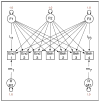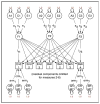Twin studies and their implications for molecular genetic studies: endophenotypes integrate quantitative and molecular genetics in ADHD research
- PMID: 20732624
- PMCID: PMC3148177
- DOI: 10.1016/j.jaac.2010.06.006
Twin studies and their implications for molecular genetic studies: endophenotypes integrate quantitative and molecular genetics in ADHD research
Abstract
Objective: To describe the utility of twin studies for attention-deficit/hyperactivity disorder (ADHD) research and demonstrate their potential for the identification of alternative phenotypes suitable for genomewide association, developmental risk assessment, treatment response, and intervention targets.
Method: Brief descriptions of the classic twin study and genetic association study methods are provided, with illustrative findings from ADHD research. Biometrical genetics refers to the statistical modeling of data gathered from one or more group of known biological relation; it was apparently coined by Francis Galton in the 1860s and led to the "Biometrical School" at the University of London. Twin studies use genetic correlations between pairs of relatives, derived using this theoretical framework, to parse the individual differences in a trait into latent (unmeasured) genetic and environmental influences. This method enables the estimation of heritability, i.e., the percentage of variance due to genetic influences. It is usually implemented with a method called structural equation modeling, which is a statistical technique for fitting models to data, typically using maximum likelihood estimation. Genetic association studies aim to identify those genetic variants that account for the heritability estimated in twin studies. Measurements other than those used for the clinical diagnosis of the disorder are popular phenotype choices in current ADHD research. It is argued that twin studies have great potential to refine phenotypes relevant to ADHD.
Results: Prior studies have consistently found that the majority of the variance in ADHD symptoms is due to genetic factors. To date, genomewide association studies of ADHD have not identified replicable associations that account for the heritable variation. Possibly, the application of genomewide association studies to these alternative phenotypic measurements will assist in identifying the pathways from genetic variants to ADHD.
Conclusion: Power to detect associations should be improved by the study of highly heritable endophenotypes for ADHD and by reducing the number of phenotypes to be considered. Therefore, twin studies are an important research tool in the development of endophenotypes, defined as alternative, more highly heritable traits that act at earlier stages of the pathway from genes to behavior. Although genetic variation in liability to ADHD is likely polygenic, the proposed approach should help to identify improved alternative measurements for genetic association studies.
2010 American Academy of Child and Adolescent Psychiatry. Published by Elsevier Inc. All rights reserved.
Figures


Comment on
-
The new genetics in child psychiatry.J Am Acad Child Adolesc Psychiatry. 2010 Aug;49(8):729-35. doi: 10.1016/j.jaac.2010.06.010. J Am Acad Child Adolesc Psychiatry. 2010. PMID: 20643308 No abstract available.
References
-
- Burt SA. Rethinking environmental contributions to child and adolescent psychopathology: a meta-analysis of shared environmental influences. Psychol Bull. 2009;135:608–637. - PubMed
-
- Faraone SV, Perlis RH, Doyle AE, et al. Molecular genetics of attention-deficit/hyperactivity disorder. Biol Psychiatry. 2005;57:1313–1323. - PubMed
-
- Luciano M, Wright M, Smith GA, Geffen GM, Geffen LB, Martin NG. Genetic covariance among measures of information processing speed, working memory, and IQ. Behav Genet. 2001;31:581–592. - PubMed
-
- Pearl J. Causality: Models, Reasoning, and Inference. Cambridge, UK: Cambridge University Press; 2000.
Publication types
MeSH terms
Grants and funding
LinkOut - more resources
Full Text Sources
Medical

